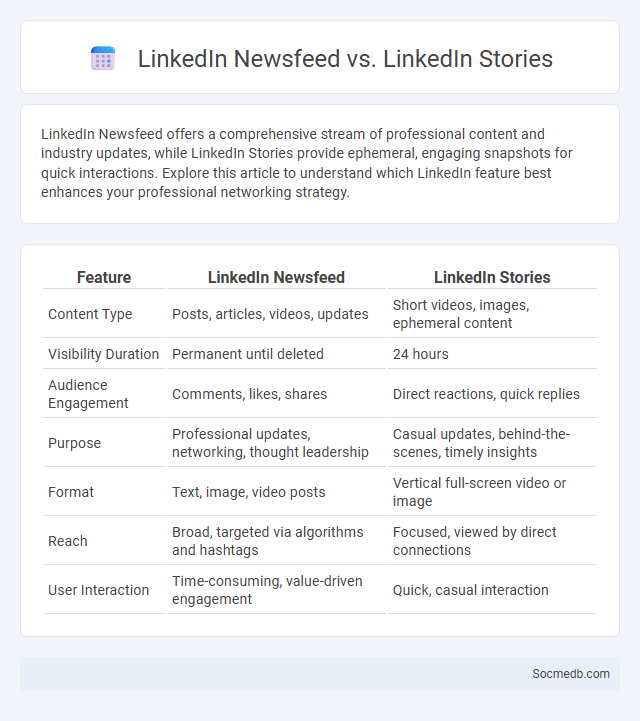
Photo illustration: LinkedIn Newsfeed vs LinkedIn Stories
LinkedIn Newsfeed offers a comprehensive stream of professional content and industry updates, while LinkedIn Stories provide ephemeral, engaging snapshots for quick interactions. Explore this article to understand which LinkedIn feature best enhances your professional networking strategy.
Table of Comparison
| Feature | LinkedIn Newsfeed | LinkedIn Stories |
|---|---|---|
| Content Type | Posts, articles, videos, updates | Short videos, images, ephemeral content |
| Visibility Duration | Permanent until deleted | 24 hours |
| Audience Engagement | Comments, likes, shares | Direct reactions, quick replies |
| Purpose | Professional updates, networking, thought leadership | Casual updates, behind-the-scenes, timely insights |
| Format | Text, image, video posts | Vertical full-screen video or image |
| Reach | Broad, targeted via algorithms and hashtags | Focused, viewed by direct connections |
| User Interaction | Time-consuming, value-driven engagement | Quick, casual interaction |
Overview: LinkedIn Newsfeed vs LinkedIn Stories vs Traditional Newsfeed
LinkedIn Newsfeed offers a professional content stream tailored to industry updates, long-form posts, and shared articles, optimizing engagement with your network. LinkedIn Stories provide ephemeral, visual-centric updates ideal for real-time insights and more personal connections within your professional circle. Compared to a traditional newsfeed, LinkedIn's features emphasize career growth and professional development, ensuring your content reaches a targeted audience seeking business and networking opportunities.
What is the LinkedIn Newsfeed?
The LinkedIn Newsfeed is a dynamic content stream on LinkedIn where users discover updates, articles, job postings, and professional insights shared by connections and followed companies. It leverages an algorithm that prioritizes relevant, personalized content based on user interactions, industry trends, and network activity. Businesses and professionals use the Newsfeed to enhance visibility, engage with their audience, and build industry authority.
What are LinkedIn Stories?
LinkedIn Stories are short, engaging video or photo updates that appear at the top of the LinkedIn mobile app, designed to share professional moments in a casual, visually appealing format. These stories disappear after 24 hours, encouraging timely and authentic interactions among connections and followers. Optimized for networking, LinkedIn Stories enhance real-time engagement and personal branding within the professional community.
Defining the Traditional Social Media Newsfeed
Traditional social media newsfeeds are curated streams of content that prioritize posts based on user interactions, relevancy algorithms, and chronological order. Your experience is shaped by the platform's algorithm, which selects updates from friends, pages, and groups to maximize engagement and keep you informed. This tailored content delivery system aims to balance personal connections with trending topics within your network.
Content Types: Comparing Formats and Engagement
Analyzing social media content types reveals that videos generate 120% higher engagement than images and text posts combined, driven by dynamic storytelling and visual appeal. Infographics deliver complex information efficiently, increasing shareability by 80%, while live streams foster real-time interaction, boosting viewer retention rates by up to 60%. Carousel posts enhance user interaction by encouraging swipes, resulting in 1.4 times more engagement compared to single-image posts.
Audience Reach and Demographics
Social media platforms provide unparalleled audience reach, with over 4.7 billion active users worldwide engaging daily across channels like Facebook, Instagram, TikTok, and LinkedIn. Demographic targeting allows marketers to tailor content based on age, gender, location, interests, and behavior, enhancing engagement and conversion rates. Understanding platform-specific user demographics enables precise campaigns that maximize impact and return on investment.
User Interaction: Stories vs Newsfeed Engagement
User interaction on social media varies significantly between Stories and Newsfeed engagement, with Stories generating higher immediacy and intimacy due to their ephemeral nature and vertical video format. Stories encourage active participation through features like polls, questions, and direct messaging, resulting in more personalized user responses and real-time feedback. In contrast, Newsfeed content drives broader engagement through likes, comments, and shares, benefiting from algorithm-driven visibility and longer content lifespan.
Algorithm and Visibility Differences
Social media algorithms prioritize content based on user engagement metrics such as likes, shares, and comments, which significantly influence content visibility on platforms like Facebook, Instagram, and TikTok. These algorithms use machine learning to personalize user feeds, resulting in varied visibility for posts depending on the audience's preferences and interaction history. Differences in algorithm design lead to disparities in organic reach, where some content creators experience heightened visibility while others struggle to gain exposure without paid promotion.
Best Practices for Brands and Professionals
Consistent branding across platforms enhances recognition and trust, while engaging content tailored to the target audience drives higher interaction rates. Leveraging data analytics helps optimize posting schedules and content strategies for maximum reach and impact. Prioritizing authentic engagement and timely responses fosters stronger community relationships and brand loyalty.
Choosing Between Stories and Newsfeed: Strategic Considerations
Choosing between social media Stories and Newsfeed posts involves analyzing audience engagement metrics and content longevity. Stories offer ephemeral, time-sensitive interactions ideal for real-time updates and limited promotions, while Newsfeed posts provide sustained visibility suitable for in-depth information and brand storytelling. Brands must align their strategy with target demographics, platform algorithms, and campaign objectives to maximize reach and interaction.
 socmedb.com
socmedb.com